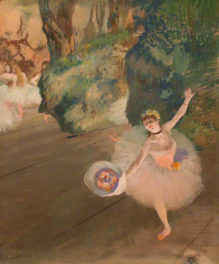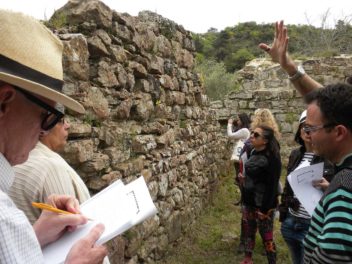
Aerial view of the Getty Center looking toward the Pacific Ocean.
The Getty Center opened to the public on December 16, 1997, providing a new home for the arts institution founded by J. Paul Getty on a much smaller scale in 1953. Here on The Iris, the Getty’s president and the directors of our four programs will reflect on our past 20 years and the Getty’s relationship with Los Angeles. This first post is adapted from the foreword to the forthcoming J. Paul Getty Trust Report, publishing online and in print in February 2018, which honors the legacy of Harold M. Williams (1928–2017), who passed away on July 30. —Ed.
Harold M. Williams was hired in 1981 as the first president of what would become the J. Paul Getty Trust. Sixteen years later the Getty Center opened in Brentwood, the physical realization of a vision for a single institution devoted to the visual arts, from research and conservation to presentation and interpretation.
On the twentieth anniversary of the opening of the Getty Center, it is fitting to remember how the Getty came to be what it is today, and to think about where we are headed next.
Origins of the Getty Center
J. Paul Getty’s final wish was to see the bulk of his estate used for “a museum, gallery of art, and library for the diffusion of artistic and general knowledge.” Harold’s task was to find out how to best accomplish that vision.
With characteristic frankness, Harold once told a colleague: “I don’t care what I think the Getty ought to do, and I certainly don’t care what you think the Getty ought to do. Our job right now is to go out and see where the interstices are, where this unusual place with unusual resources and an operating foundation can make a difference.”

Harold Williams touring the Getty Center construction progress.
Having hired Leilani Lattin Duke and Nancy Englander—two seasoned program officers with years of experience at the National Endowment for the Arts and the Humanities, respectively—he embarked on what he called “a year of exploration.” The team traveled throughout North America and Europe to interview professionals working in art history, conservation, and museums.
Harold walked away from that year with the observation that existing visual arts institutions all favored one aspect of practice over others. Academic institutions focused on research; museums on collecting, interpreting, and displaying objects; conservation centers on science. Few focused on art education. Harold and his team saw a need for an institution that would bring together all of these elements as partners in a single institution. They also saw an opportunity for supporting collaboration across these elements, and made building a central campus for the museum and new programs of the Getty Trust an imperative.
“We began to envision the Getty Center as a place that would foster collaboration and synergy among the programs and provide specialized facilities and space to meet their long-term needs,” said Harold. At the same time, “we also felt the project should make a significant architectural statement and create a new and unique cultural resource for the city of Los Angeles.”
A search for a location in Los Angeles ended with the purchase of several hilltop lots totaling 110 acres in the Santa Monica Mountains in 1983, and the next year an international search closed with the selection of architect Richard Meier to design the Getty Center. Meier pursued the project with an interest in finding “a balance between the man-made and natural worlds, between the Trust’s classical concerns and the hilltop’s rugged setting. The Getty Center is an attempt to give new form to age-old traditions, to create a place where art and scholarship can achieve new meaning.”
The completion of the Getty Center is not the end of a process, but the beginning.
—Harold Williams, first Getty president
After ten years of construction, the Getty Center opened to the public on December 16, 1997. It has since welcomed millions of visitors to enjoy art both in its galleries and throughout the grounds, and hosted thousands of scholars and scientists pursuing advanced research in art history and cultural heritage conservation.
This work has continued and accelerated since 1997, both at the Getty Center itself and through our international projects that rely on the Center as home base. Harold once remarked that the biggest danger the Getty would face was “a sense of being self-satisfied. ‘Gee, aren’t we great.’ That concerns me a lot. Because if that happens, we’ve failed.” And we are still not satisfied.

Photo of the Museum Entrance Hall under construction by Dennis Keeley
The Getty Today and Tomorrow
As proposed by Harold, the Getty’s earliest mission was simple and profound: “to do what needs to be done in our fields of expertise that others are not doing or cannot do.” Today, our mission is still concise and directed, but also broad enough to allow the Getty to pursue a variety of work that serves the visual arts. We are “dedicated to the presentation, conservation, and interpretation of the world’s artistic legacy.”
We are currently in our fourth year of pursuing our current strategic goals set in 2014, which are directed at serving both specialist and general audiences in Los Angeles and throughout the world to further the understanding of art and to promote civil society:
- To be recognized as a leader in our domains—art history, conservation, and museology—and known for our research-based work, which we disseminate broadly in print and online, we are supporting new technologies that will increase public access to, and more sophisticated research into, the arts and humanities. We are digitizing collections to make them available online free of charge, investing in the creation of deep databases and online analytical tools such as the ARCHES platform for inventorying and managing immovable heritage, and promoting field-wide standards in digital art history.
- To strengthen and broaden our collections and be recognized as among the most ambitious collecting museums and research libraries in the world, we continue to acquire significant works of art and archives. In just the past few years, the Getty Museum has acquired several major paintings and sculptures: the Borghese-Windsor cabinet, a group of 16 Old Master drawings, and, with the Getty Research Institute and the Los Angeles County Museum of Art, the extensive archive of photographer Robert Mapplethorpe. The Getty Research Institute has acquired the Harald Szeemann Archive, the Ed Ruscha Streets of Los Angeles Archives, the Knoedler Gallery Archive, and the Richard A. Simms Collection of modern German prints and drawings—to name just a few.
- To be recognized as a world leader at the intersection of art, humanities, and cultural and public policy, we have convened a working group to explore a new international framework for the protection of cultural heritage in conflict zones that would recognize the nation state’s primary responsibility to protect cultural heritage within its jurisdiction. If the state is unable or unwilling to do so, the international community would have an obligation to assist the state in the protection of cultural heritage under its care, and then, if that failed, to intervene to protect it.
- To engage with communities and audiences at all levels to ensure that the Getty plays a leading role in the cultural life of Los Angeles and is recognized as the preeminent visual arts institution in the region and on the West Coast, we launched large, region-wide art initiatives—Pacific Standard Time: Contemporary Art in L.A., 1945–1980 and Pacific Standard Time: LA/LA—the latter comprising more than 80 visual arts exhibitions at more than seventy museums, more than 500 performances and public programs, and more than 60 scholarly publications.
- To build a substantial and robust community of supporters deeply engaged in and identified with the Getty, we have launched the Getty Patron Program, increased our docent corps to more than 500 members, and evolved the ways we use digital media to engage audiences, and engage deeply with grantees, visiting scholars, and members of our support councils.

The Getty Research Institute and the Getty Museum actively acquire significant archives and works of art. Left: Mass of the Earth Supported by an Ox Floating on the Ocean from Kitāb al-ʻajāʼib wa al-gharāʼib (Book of Wonders and Oddities), 1553. Text by Zakariya ibn Muhammad al-Qazwini. The Getty Research Institute, 2010.M.65. Gift of Lawrence J. Schoenberg. Right: Young Italian Woman at a Table, about 1895–1900, Paul Cézanne. Oil on canvas, 36 1/4 × 28 15/16 in. The J. Paul Getty Museum, 99.PA.40
We pursue these goals with a mind always on what we can help accomplish in the future. Future strategic goals for 2019 and beyond include:
- Building on the first 25 years of our Multicultural Undergraduate Internships, which, in the interest of increasing the diversity of professional staff in the visual arts, has placed more than 3,200 interns from diverse backgrounds at over 160 local arts institutions;
- Strengthening our position as a leader in the technical study of works of art by combining art history and conservation science in joint research, publication, and exhibition projects and by developing new open-source tools for analyzing deep data;
- Bolstering our leadership in digital imaging and image analysis, including through promoting the International Image Interoperability Framework (IIIF);
- Advancing transnational and interdisciplinary studies in the histories of art;
- Expanding the reach and quality of Pacific Standard Time, the Getty-led exhibition, performance, and education initiative;
- Extending and enriching our engagement with the region’s schools and school districts, on site and online; and,
- Confronting the growth of the Getty and the changing habits of work and developing a master plan to meet future public, staff, and collection space needs.
On the eve of the Getty Center’s opening in 1997, Harold Williams wrote, “In the decades ahead, the Getty must continually reexamine its role locally, nationally, and internationally. It can strive to fulfill its mission only insofar as it remains alert and responsive to the needs of all the communities it serves.” Twenty years later, we recommit to continual reexamination in the service of our mission and our audiences.




Never get tired of visiting and spending time at such a magnificent place…..oh ..
there is art too!!!!!
I watched being built and never forget our first ride up and down (backwards) on the tram. Such a view.
Congratulations and thank you for 20 years.
Merry Christmas and Happy 2018,Getty!!
One of my favorite museums! Always a pleasure to visit. Happy 20th! Here’s to another 200 years and beyond!
In 20 years, the Getty acquired a Bernini, a Parmigianino, a Rembrandt self-portrait, a Turner, a Gauguin, 2 Manets, and 2 Watteaus. Thanks for keeping it interesting every year.
Please buy the Manet and Seurat paintings being auctioned next spring from the Rockefeller estate. They are so beautiful.